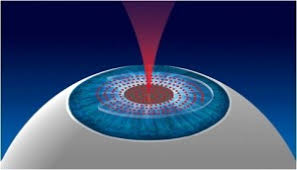Lasik surgery is a common procedure used to correct vision problems. There are two main types of Lasik surgery: blade and all-laser. Blade Lasik is the older type of surgery, and all-laser Lasik is the newer, more advanced type. In this blog post, we will discuss the pros and cons of both types of surgery.
Contents
What Is Blade Lasik?

Blade Lasik is a type of laser eye surgery that uses a blade to make a thin flap in the cornea. The surgeon then uses a laser to reshape the inner layers of the cornea. Blade Lasik is also called conventional or standard Lasik.
In this type of surgery, an instrument called a microkeratome or femtosecond laser is used to create a thin flap in the cornea. The surgeon then lifts the flap and uses another laser to reshape the inner layers of the cornea. Blade Lasik has been performed since the early 1990s and is the most common type of Lasik surgery.
Is Blade Lasik Painful?
Blade Lasik is not a pain-free procedure. You may feel some discomfort during the surgery, as well as after the surgery while your eyes are healing. Most people report that the pain is manageable and does not last long. Some people may need to take pain medication for a day or two after their surgery.
How Does Blade Lasik Works?

Blade Lasik works by using a laser to create a thin flap in the cornea. The surgeon then folds back the flap, exposing the underlying tissue. The laser is then used to sculpt the tissue, changing its shape so that light can be properly focused on the retina. The flap is then replaced, and the eye heals naturally.
Blade Lasik can correct a wide range of vision problems, including nearsightedness, farsightedness, and astigmatism. It can also be used to treat presbyopia, a common condition that affects people over the age of 40.
Blade Lasik is safe and effective, and most people experience little to no discomfort during the procedure. Recovery is usually quick, and most people see an improvement in their vision within a day or two.
What are the Pros And Cons of Blade Lasik?

There are various pros of blade Lasik. They are as follows:
PROS
1. The surgery is very precise and can be controlled very easily.
2. There is much less tissue damage as compared to other methods of Lasik surgery.
3. There is a reduced risk of infection because the surgeon has complete control over the instruments.
4. The procedure is relatively quick and painless.
5. Recovery is also quick, and most people can return to their regular activities within a day or two.
6. The results of this are usually very good, and the majority of people achieve a 20/20 vision or better.
CONS
1. It is more expensive than other types of Lasik surgery.
2. There is a slightly higher risk of complications than with other types of this surgery.
3. Some people may experience more side effects and discomfort than other types of Lasik surgery.
4. The results of it may not be as good as the results of other types of Lasik surgery.
5. It is not suitable for everyone, and some people may not be able to have the surgery because of their eye shape or other factors.
Overall, It has many pros and a few cons. It is important to weigh the pros and cons carefully before deciding if this surgery is right for you. If you have any questions or concerns, be sure to talk to your eye doctor.
However, there are also some potential disadvantages to Blade Lasik. First, the surgery is not reversible, meaning that if something goes wrong, it cannot be undone. Additionally, this can sometimes result in visual distortions such as halos around lights. Finally, as with any surgery, there is always a risk of complications such as infection.
How Are Blade And Bladeless Lasik Different?
The difference between bladeless and blade LASIK is the way in which the corneal flap is created.
In bladeless LASIK, an instrument called a femtosecond laser is used to create the corneal flap. The femtosecond laser emits short pulses of energy that pass through the eye’s natural lens and focused on the cornea. The energy from the laser disrupts the bonds between the water and protein molecules in the cornea, making it possible to create a clean, uniform cut with minimal tissue damage.
In blade LASIK, a hand-held instrument called a microkeratome is used to create the corneal flap. The microkeratome consists of a metal blade that vibrates back and forth at a high speed. As the blade moves across the surface of the cornea, it creates a thin flap of tissue.
While both bladeless and blade LASIK are effective methods for vision correction, there are some advantages to bladeless LASIK. Because the femtosecond laser is more precise than the microkeratome, it can create a thinner and more uniform flap. This can reduce the risk of complications such as irregular astigmatism. In addition, bladeless LASIK is less likely to cause side effects such as dry eye and glare.
Overall, it is important to discuss the pros and cons of both bladeless and blade LASIK with your eye doctor to decide which type of surgery is right for you.
Conclusion
It may be concluded that blade Lasik is a good choice for those who are looking for a safe and effective way to improve their vision. However, it is important to consult with an experienced eye doctor to ensure that this procedure is right for you.
If you want to know more about this option, please contact Eye Mantra. This platform offers the most advanced surgical options for your eyes including PRK, Femto Lasik, SMILE surgery, Standard LASIK, and Contoura vision. If you have any questions on LASIK surgery, LASIK surgery cost, and LASIK procedure, call us at +91-9711116605 or email at [email protected].


